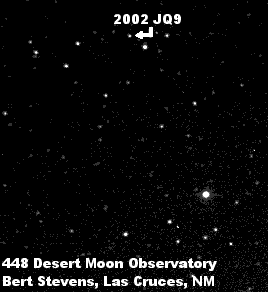Unlike most scientific disciplines, where only professionals tend to contribute to the current body of science, astronomy still relies heavily on input from amateur scientists. Several of our members are involved in scientific research including minor planet discovery and characterization, variable star observations, and occultation timing. The following information outlines some of the contributions our members make to the science of astronomy.
 Asteroids (or as astronomers call them, "minor planets") mostly orbit the Sun between Mars and Jupiter. But not all do. Some come very close to the Earth. A few actually hit the Earth - some causing mass extinctions. A new impact might extinguish Homo Sapiens - a group that includes the members of this club (among others). So some ASLC members track minor planets, watching for the one out of hundreds of thousands that may impact the Earth.
Asteroids (or as astronomers call them, "minor planets") mostly orbit the Sun between Mars and Jupiter. But not all do. Some come very close to the Earth. A few actually hit the Earth - some causing mass extinctions. A new impact might extinguish Homo Sapiens - a group that includes the members of this club (among others). So some ASLC members track minor planets, watching for the one out of hundreds of thousands that may impact the Earth.
Very precise measurements of the positions of these Near Earth Objects (NEOs) are required to determine the likelihood of an Earth impact. The Minor Planet Center of the International Astronomical Union tracks the positions and computes the orbits of all minor planets. They, and others, provide a recommendation as to which NEOs need to be observed most urgently to improve our knowledge of their orbit.
As night falls, asteroid hunters around the world power-up their observatories, and feed the computer's control system the list of objects to observe. The telescope will work all night, moving from object to object under computer control. It will automatically check to see if it is pointed at the right part of the sky, focus itself, and take the required number of images. Using the background stars as a reference frame, the position of the minor planet can then be accurately determine. That data is emailed to the Minor Planet Center to improve the accuracy of the orbit of the minor planet. Results from all over the world are published each night in the Daily Orbit Update.
We all hope that we will never find a minor planet that will impact the Earth. Whether we would be able to stop such an impact is uncertain, but the more advance notice we have of such an event, the more likely we can prevent the impact. So we keep imaging the sky on almost every clear night, hoping that none of the NEOs we measure will become the one that will change history.
Bert and Janet Stevens' Minor Planet Discoveries
All are main-belt asteroids unless noted otherwise
(click on an asteroid to see its orbital path)

